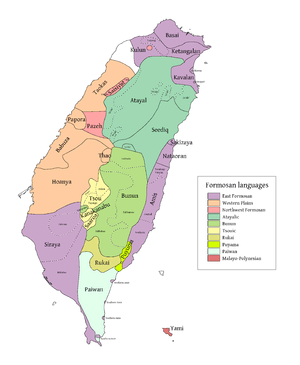Favorlang language
| Favorlang | |
|---|---|
| Native to | Taiwan |
| Extinct | (documented mid-17th century) |
|
Austronesian
| |
| Language codes | |
| ISO 639-3 |
bzg (with Babuza) |
| Glottolog | None |
Favorlang is an extinct Formosan language closely related to Babuza.
Although Favorlang is considered by Taiwanese linguist Paul Jen-kuei Li to be a separate language, it is nevertheless very closely related to Babuza. In fact, the name Favorlang is derived from Babuza.[1] Alternatively, Favorlang may also have represented a dialect of Babuza at an earlier stage, since Favorlang was documented in the mid-17th century, while Babuza was documented only around the turn of the 20th century by Japanese linguists.[2]
Phonology
Favorlang has gone through the following sound changes. Except for the *t, *s, *Z > /t/ merger, all of these sound changes are shared by the five Western Plains languages Taokas, Babuza, Papora, Hoanya, and Thao.[3]
- Merger of PAn *n and *ŋ as /n/
- Merger of *t, *s, *Z as /t/
- Merger of *N and *S1 as /s/
- Complete loss of *k, *q, *H
- Partial loss of *R, *j, including the loss of final *-y and *-w
- *s (in initial and medial positions) > /t/
Sources
Favorlang data sources are:[4]
- Happart, Gilbertus (1650). Woorden boek der Favorlangsche Taal [Favorlang Vocabulary] (in Dutch). Later translated into English:
- Happart, Gilbertus (1840) [1650]. Written at Batavia. Dictionary of the Favorlang dialect of the Formosan language. transl. Medhurst, W. H. Parapattan.
- 5 sermons and various prayers, questions, and answers on Christianity by Jacobus Vertrecht (1647–1651), a Dutch pastor
- Word lists collected by Naoyoshi Ogawa in the early 1900s (unpublished manuscripts dated 1900, 1901, and 1930; others are undated)
- Notebooks 1, 2, 3, and 5, now kept by ILCAA (Research Institute for Languages and Cultures of Asia and Africa) and TUFS (Tokyo University of Foreign Studies) – call number "OA052"
- Notebook 4, now kept at the Anthropological Institute, Nanzan University – call number "v. 1-2-1"
Syntax
Case markers include:[5]
- ja 'nominative marker'
- ta 'personal name marker'
- o, no 'oblique (genitive and accusative, common noun)'
- i 'oblique (personal noun)'
- de 'locative'
- i 'directional'
Agent-focus verbal affixes include:[6]
- Agent-focus
- -um- ~ -umm- (after consonant-initial verb stems) or um- ~ umm- (before vowel-initial verb stem except i-)
- -im-, -em- (lexically conditioned)
- m-
- p-
- Past tense (AF)
- -in-umm-, in-umm
- m-in-
- -in-
- Future tense (AF)
- Reduplication of the first stem syllable
- Imperative (AF)
- -a
Non-agent-focus verbal affixes are:[6]
- -an 'locative focus'
- -en, -in, -n 'patient focus'
- ipa- ... -a 'imperative (non-agent-focus)'
- -in-, in- 'past tense (non-agent-focus)'
- ino- 'future tense (non-agent-focus)'
When -in- and -umm- appear together in a word, -in- usually precedes -um- ~ -umm-, as in Ilokano, Bontok, and some Dusunic languages in Sabah (Rungus Dusun and Kimaragang Dusun). Occasionally, -umm- precedes -in- in several Favorlang lexical forms, but this is not very common.
Pronouns
All of the following personal pronouns are free forms. All genitive pronouns end with -a.
| Type of Pronoun |
Neutral | Genitive | Nominative/Accusative |
|---|---|---|---|
| 1s. | ka-ina | na-a | ina |
| 2s. | ijonoë | joa, oa | ijo |
| 3s. | icho | choa | icho |
| 1p. (incl.) | torro | torroa | - |
| 1p. (excl.) | namono | namoa | namo |
| 2p. | imonoë | imoa | imo |
| 3p. | aicho-es dechonoë | choa | decho |
Examples
- Namoa tamau tamasea paga de boesum, ipa-dass-a joa naan.
- Our father, which art in Heaven, let Thy Name be praised![7]
- Ka-ina paga ta Jehova oa Deosoe, tamasea pina-ijor ijo....
- I am the Lord, thy God, who led thee....[7]
- The Lord's Prayer[8]
Namoa tamau tamasea paḡa de boesum,
Ipádassa joa naan.
Ipáṣaija joa chachimit o ai.
Ipa-i-jorr'o oa airab maibas de boesum, masini de ta channumma.
Epé-e namo-no pia-dai torro uppo ma-atsikap.
Ṣo-o abó-e namo tataap o kakossi namoa,
maibas channumma namo mabo tamasea parapies i namo.
Hai pásabas i namo, ṣo-o barra'i namo innai rapies ai.
Inau joa micho chachimit o ai, ṣo-o barr'o ai, ṣo-o adas ai, taulaulan,
Amen.
References
- ↑ Li (2003), p. 3.
- ↑ Li (2003), p. 5.
- ↑ Li (2003), p. 6.
- ↑ Li (2003), p. 1.
- ↑ Li (2003).
- 1 2 Li (2003), p. 11.
- 1 2 3 Li (2003), p. 8.
- ↑ Campbell, William, ed. (1896). The articles of Christian instruction in Favorlang-Formosan, Dutch and English, from Vertrecht's manuscript of 1650. London: Kegan Paul, Trench, Trübner & Co. Ltd. OCLC 63842595. OL 24180153M.
- Li, Paul Jen-kuei (2003). "Introduction: Notes on Favorlang, an Extinct Formosan language". In Ogawa, Naoyoshi. English-Favorlang vocabulary. Tokyo: Research Institute for Languages and Cultures of Asia and Africa. pp. 1–13. ISBN 4872978536.
- Ogawa, Naoyoshi (2003). English-Favorlang vocabulary. Tokyo: Research Institute for Languages and Cultures of Asia and Africa. ISBN 4872978536.
- Marsh, Mikell Alan (1977). Favorlang-Pazeh-Saisiat: a putative Formosan subgroup (Ph.D. dissertation). Washington State University. OCLC 224303389.

